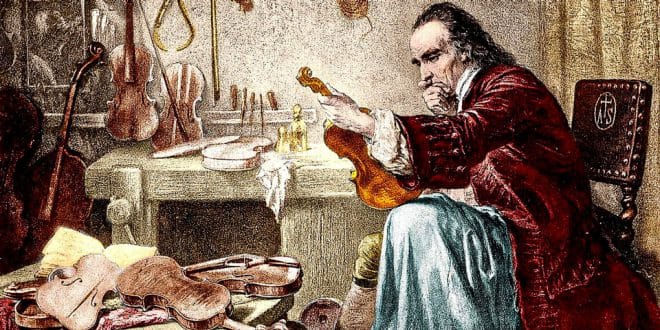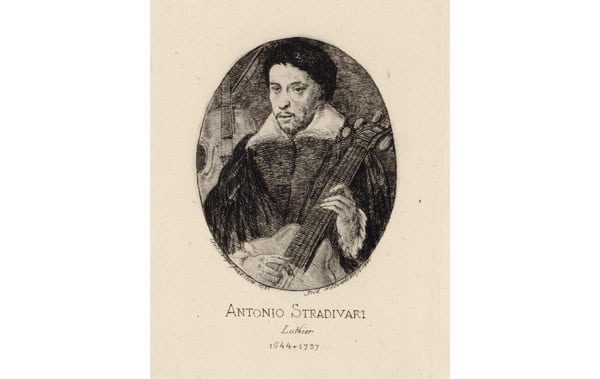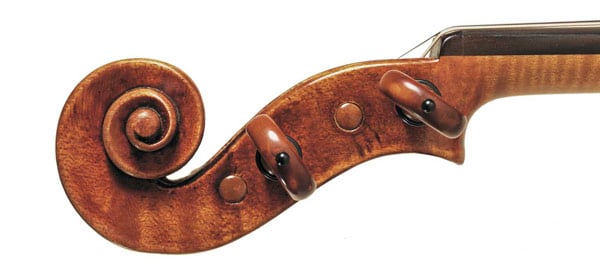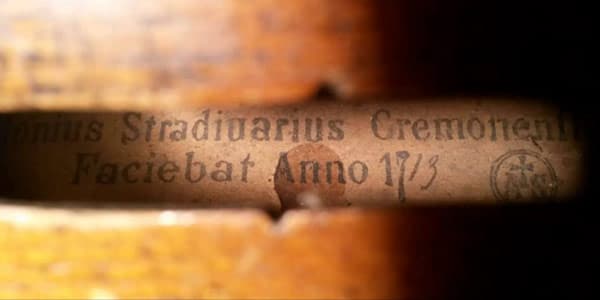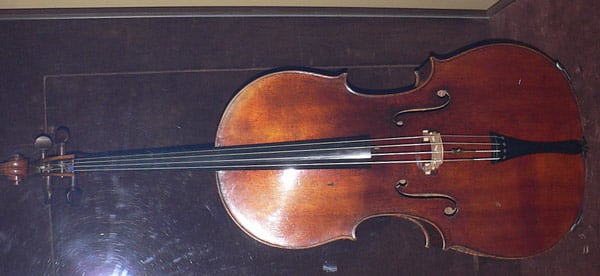Antonio Stradivari is considered a virtuoso in the craft of violin and bow instrument making. His masterpieces are compared to a female voice because they sound sensual, smooth, and gentle.
Stradivari violins represent what Italians traditionally call “dolce vita” (translated as “sweet life”). Antonio was a student of Nicola Amati, who was renowned for creating various antique instruments, including cellos.
Page Contents
Biography
The exact date of Antonio Stradivari’s birth is not registered, but numerous historians agree that the master was born in 1644 in the Italian town of Cremona, Lombardy region.
His father’s name was Alessandro Stradivari, and his mother’s name was Anna Moroni.
Early Work and the First Violin
The master’s first violin dates back to 1666, and during its making, Stradivari strictly adheres to the technique he learned from his mentor. Therefore, the instruments of that time were symbolically referred to as “amatises.”
After the future master got married, he decided to engage in his own instrument making. In 1667, he settles in a fisherman’s house, where he opens his first workshop. His wife, Francesca Feraboski, becomes his spouse and blesses the master with six children. Two of them, Francesco and Omobono, later developed a passion for the art of crafting musical instruments and became loyal assistants to Antonio.
When Stradivari starts producing his own violins, he no longer marks them as Amati’s, nor does he refer to himself as Amati’s student. Now Antonio is an independent master. However, he did not become one immediately, as throughout his stay in the fisherman’s cottage, he learns the art of wood carving from the owner, Francesco Pescaroli. According to biographers, it was Francesco who taught the master to excel in the intricacies and details of inlay work.
By the beginning of 1680, the master had crafted a variety of instruments, including not only violins and cellos but also mandolins, harps, guitars, and lutes.
In 1681, with the money earned from his early instruments, Stradivari purchases a house located near the Dominican monastery in his hometown. The house had a basement, several mezzanines, and a small square structure on the roof. It opened from the south and west sides and housed drying rooms where Antonio enjoyed working in good weather and drying his instruments after applying varnish. The master strived to make each violin a true work of art, dedicating ample time to each instrument, listening to its sound and sensing the slightest deviation.
Antonio Stradivari’s magnificent creations were hard to miss, and before long, his instruments began to attract admirers. The master had the unique opportunity to experience what it was like to be recognized and have a privileged social position during his lifetime. As musicians increasingly started ordering work from Stradivari, the master finally achieved financial prosperity.
Subsequent Instrument Making
Until 1684, the influence of Nicolò Amati could be strongly felt in Antonio Stradivari’s masterpieces, as he endeavored to follow the teachings of the true virtuoso, which had been passed down to him. However, once Nicolò passed away, Stradivari began to explore something new, experimenting and creating musical instruments according to his own vision of what was right. The master was constantly in search of the perfect combination of a unique and elegant appearance with a pure sound.
In 1698, a tragic event befell Stradivari when his beloved Francesca passed away. However, Antonio did not remain alone for long, and a year later, he entered into another marriage. This time, his chosen partner was Antonia Maria Zambelli. They had five children together, but none of them followed in their father’s footsteps. The children were unable to inherit the master’s talent.
The first two decades of the subsequent century are considered the most successful and “golden” in Antonio Stradivari’s life. It was during this period that the genius created his finest instruments, renowned for their unique sound and impeccable design.
In the early 1730s, as the 18th century began, the master continued his work, albeit with less intensity due to his advancing age and health problems. Stradivari started to notice that his hand was not as steady as before, making it impossible for him to carry out the intricate jewelry work on his creations. Nevertheless, Stradivari did not abandon instrument making even with one foot in the grave. He decided to produce fewer instruments but with a focus on quality. Antonio devoted himself to each violin until he was completely satisfied with its sound.
Throughout his life, Stradivari had only three apprentices—his two sons and Carlo Bergonzi, a violin maker and representative of the Cremonese school. However, none of these followers could reach the same level of craftsmanship nor possessed the necessary talent to surpass the genius himself.
Marking
Stradivari marked his created instruments with a distinctive inscription in Latin: “Antonius Stradivarius Cremonensis Faciebat Anno.”
On special labels, the master placed the notation “d’anni 92” in 1736 and “d’anni 93” the following year, indicating his age.
Death of the Master Antonio Stradivari
The master passed away on December 18, 1737, in his hometown of Cremona in northern Italy, where he had lived his entire life. Stradivari was in his advanced years, at the age of 93. By the standards of that time, this was incredibly long, and Antonio can confidently lay claim to the title of a long-lived individual of the 17th and 18th centuries.
The final resting place of the master became the cemetery of the Dominican monastery. In 1869, the cemetery was abolished, and all the remains were exhumed from the crypt and relocated to a common grave outside the city. Therefore, the current whereabouts of Antonio Stradivari’s ashes are unknown, and he is considered to have disappeared without a trace.
According to other sources, the master found peace in the family crypt not far from the Rosario Chapel near the Basilica di S. Domenico, alongside his second wife, who had passed away a few months before Antonio.
Antonio Stradivari’s Instruments
According to various sources, the master created approximately 1150 instruments in total. Some historians suggest that, considering natural disasters, catastrophes, and social conflicts, the number of Antonio’s instruments could reach around 5,000.
Currently, around 650 Stradivari musical instruments have been preserved. The most famous among them is the Duport Cello.
Stradivari Duport
The Duport Cello (Stradivari Duport) was created in 1711 and is the most valuable among the surviving Stradivari instruments. The cello acquired its name thanks to its owner, Jean-Louis Duport, who never parted with it until his death. There is a legend that a small scratch was left on the instrument, caused by Napoleon’s spurs when he attempted to play it. The virtuoso Franchomme acquired it for 22,000 francs, after which it passed to Jean-Baptiste Vuillaume. Subsequently, the instrument changed hands several times.
From 1974 to 2007, Mstislav Rostropovich played this cello, affectionately referring to it as his “mistress.”
Stradivari Davidov
The Davidov cello (Stradivari Davidov) was made in 1708 or 1712 for the Grand Duke of Tuscany. Later, the instrument was brought to Russia by Count Apraksin. In the past century, the cello was part of the private collection of the Villegorsky family, who allowed visiting and familiar musicians to play it. In 1870, a family member gifted the instrument to Karl Davidov, whose name it still bears today. In 1964, the cello was acquired by the famous cellist Jacqueline du Pré for $90,000. However, six years later, she refused to play it. Currently, the cello is owned by American musician Yo-Yo Ma of Chinese origin.
Stradivari Servais
The Servais cello (Stradivari Servais) is most famously associated with François Servais, in whose honor the instrument was named.
The cello itself is in excellent condition, with even the original label indicating its creation in 1701. Servais played the cello for a considerable time in the Yusupov Palace, and in 1857, the instrument officially became his property. Today, this priceless Stradivarius masterpiece is exhibited at the Smithsonian Institution.
The Memory of the Master Stradivari
In 1988, a film called “Stradivari” was made about the famous master. It depicts the life of Antonio and how he embarked on the journey of creating masterpieces, showcasing the progress of his work throughout his creative path.
The Secret of Stradivari: Legends and Scientific Hypotheses
Stradivari’s instruments, known for their pure and delicate sound, were often likened to living beings by many owners. The music played on Antonio’s violin resonated with the soul of every person, allowing them to experience the multifaceted talent of the musician. These instruments helped unleash the full potential of those who possessed them.
Modern violins are crafted using advanced technologies and the finest types of wood, yet their sound is still not quite like that of a Stradivari. For several centuries, intense debates have revolved around the secret that the renowned master held. There is a speculation that Stradivari discovered the secret of creating the perfect musical instrument in a pharmacy, although what exactly the pharmacist recommended to him remains unknown.
Professor Joseph Nagivari claimed that the wood was initially subjected to chemical treatment to enhance the sound’s power and purity. However, experiments have revealed that such an approach does not affect the instrument’s sound, despite the theoretical possibility.
Modern violin makers claim that the magical sound of a violin is due to its unusual chemical composition. Then scientists from the Massachusetts Institute of Technology embarked on another experiment, during which it was revealed that the piercing and graceful sound was achieved due to a classical mistake in the process of creating the instruments.
Through experiments, it was discovered that the incomparable sound is justified by the specific F-shaped soundholes, the shape of which was made accidentally. It is impossible to avoid imperfections when cutting through the delicate wood, but the scientists unanimously agreed that it resembled a great discovery rather than the infamous mistake.
Many agree that the secret of Stradivarius violins lies in the fact that the master loved his work very much. His diligence helped him create masterpieces of legendary caliber. Currently, the secret of these magical instruments remains undisclosed. However, enthusiasts remain undeterred. Perhaps someday the centuries-old secret will be revealed, and we will finally learn what Antonio Stradivari had been hiding his whole life.
Interesting Facts about Antonio Stradivari
Antonio Stradivari’s life was filled with numerous intriguing events, among which the following stand out:
- Stradivari met Nicolò Amati when Antonio, a simple carpenter, worked in an inconspicuous workshop at a very young age. Nicolò decided to take the boy as his apprentice, not fully realizing the immense talent that fate had brought him.
- According to one legend, Amati used the internal organs of lambs to create the perfect instrument. Every morning, he sent Stradivari to a butcher shop with a secret note, in exchange, Antonio received the animal innards, specifically those from lambs aged strictly three months. Only after a long time did Stradivari realize that this was the secret ingredient that made the sound of the violins powerful, pure, and incredibly vibrant. However, Antonio himself never resorted to such measures. When asked about the secret behind his magical violins, he claimed to use a homemade varnish made from the wings and legs of insects that he found on the floor of his workshop. Stradivari was in no hurry to reveal his secrets; he wanted to remain truly unique.
- Antonio possessed an exceptional sense of hearing, enabling him to detect even the slightest intonation imperfections. If he noticed any flaws in an instrument, he would start working on it again until he was satisfied with the result.
- The master was hardworking, and it was this quality that later spread his reputation far beyond his hometown of Cremona.
- One of Stradivari’s early innovations was the elongated body of the instrument, which allowed it to produce a stronger, richer, and more penetrating sound. Antonio began using this innovation as he gradually moved away from Amati’s influence.
- In the field of musical instrument craftsmanship, Stradivarius rightfully earned the title of innovator and revolutionary because he transformed not only the external appearance of violins but also began creating cellos according to entirely new principles. Antonio made these instruments lighter, reduced their dimensions, and improved their sound frequency.
- Due to the fact that Stradivarius violins represented immense material value, they were often targeted by thieves. In 1936, the “Gibson” violin was stolen directly from the dressing room of musician Bronislaw Huberman, almost immediately after he performed on stage. Interestingly, the thief never sold the instrument but diligently kept it for over 50 years until he realized he would soon die from a terminal illness. The thief then bequeathed the violin to his wife, without revealing its true value. Only after 4 years did the woman understand the uniqueness of the item and decided to recover the loss for a symbolic reward. She received $263,000 for the instrument, and currently, the eccentric musician Joshua Bell is the owner of the “Gibson.”
Lastly, it will be interesting to learn that the old Jewish anecdote about tailors was adapted from an old Italian anecdote about violin makers:
Quotes
During his work, Antonio Stradivari thoroughly studied the principles of violin making, delving into all aspects of this art. However, there are not many known quotes from the master. The most common one is: “Violins are not made. They are not barrels or benches. Such an instrument must be nurtured, like grapes or children.”
 Italy for me From Italy with love
Italy for me From Italy with love

